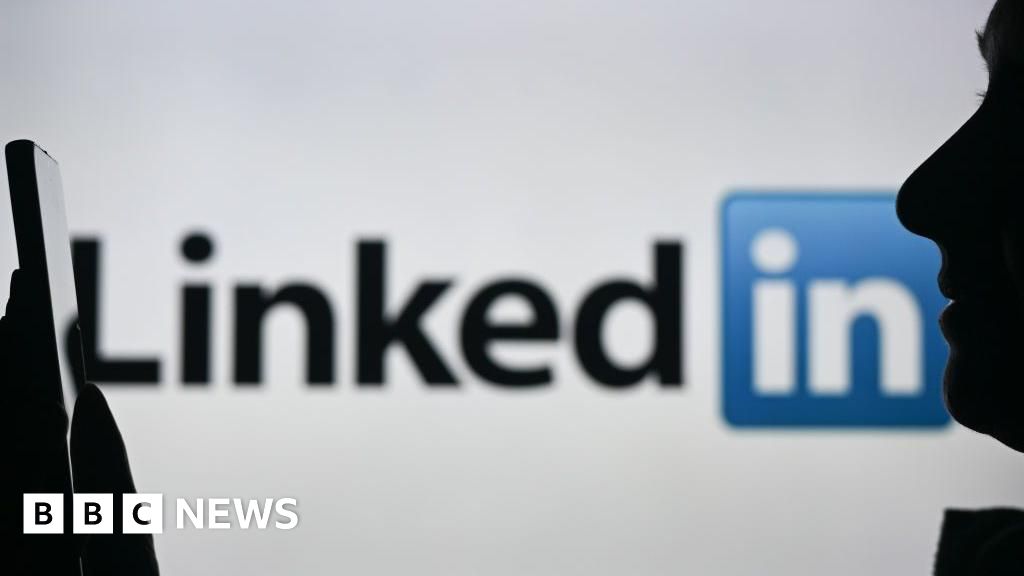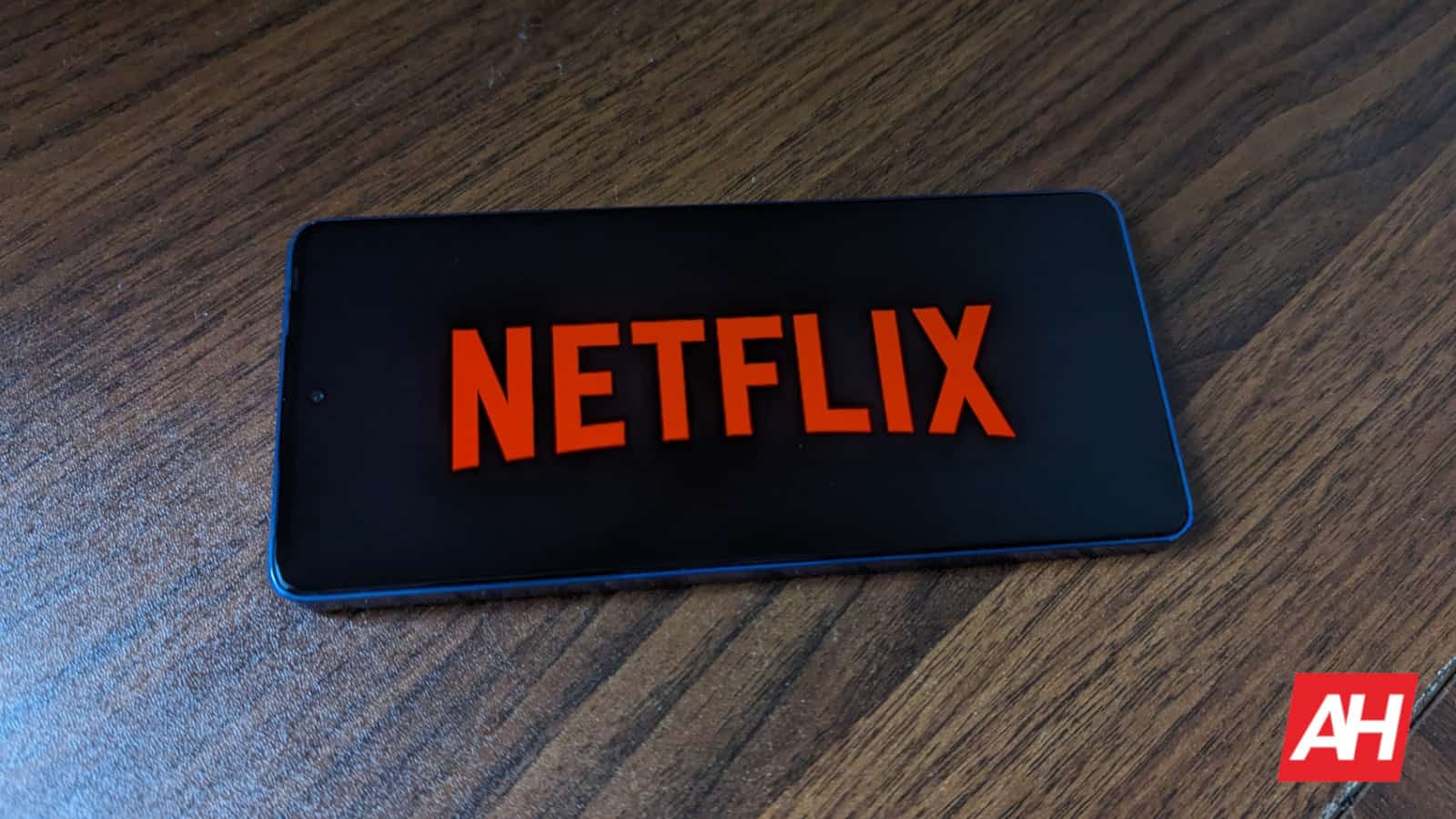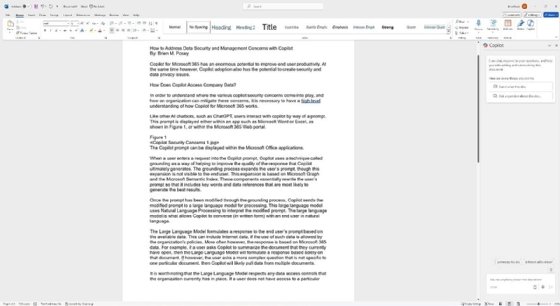Technology
LinkedIn suspends use of UK data for AI after watchdog questions

LinkedIn has suspended the use of UK user data to train its artificial intelligence (AI) models after a regulator raised concerns.
The career-focused social networking site, owned by Microsoft, quietly saw users around the world opted into their data being used to train its AI models.
But the Information Commissioner’s Office (ICO) said on Friday that it was “pleased” LinkedIn had confirmed that it had paused on using UK users’ information.
LinkedIn said it welcomes the chance to engage with the ICO further.
“We are pleased that LinkedIn has reflected on the concerns we raised about its approach to training generative AI models with information relating to its UK users,” said the ICO’s executive director, Stephen Almond.
Many big tech firms, including LinkedIn, are looking to user-generated content on their platforms as a fresh source of data for training AI tools.
“Generative” AI tools, such as chatbots like OpenAI’s ChatGPT or image generators like Midjourney, learn from huge volumes of text and image data.
But a LinkedIn spokesperson told BBC News that the company believes users should have control over their data.
As such, it has given UK users a way to opt out of having their data used to train its AI models.
“We’ve always used some form of automation in LinkedIn products, and we’ve always been clear that users have the choice about how their data is used,” they added.
Social platforms where users post about their lives, or jobs, can provide rich material to help tools sound more natural.
“The reality of where we’re at today is a lot of people are looking for help to get that first draft of that resume… to help craft messages to recruiters to get that next career opportunity,” LinkedIn’s spokesperson said.
“At the end of the day, people want that edge in their careers and what our gen-AI services do is help give them that assist.”
The company says in its global privacy policy that user data will be used to help develop its AI services, and in a help article it states that it will also be processed when users interact with tools that offer post writing suggestions, for example.
This will now not apply to users in the UK, alongside those in the European Union (EU), European Economic Area and Switzerland.
Meta and X (formerly known as Twitter) are among platforms that, like LinkedIn, want to use content posted on their platforms to help develop their generative AI tools.
But they have faced regulatory hurdles in the UK and EU, with strict privacy rules placing limits on how and when personal data can be collected.
Meta halted its plans to use UK adults’ public posts, comments and images to train its AI tools in June following criticism, and concerns raised by the ICO.
The company recently began re-notifying UK users of Facebook and Instagram about its plans and clarified its process for opting-out after engaging with the data watchdog.
LinkedIn will now likely face a similar process before it can resume plans to train its tools with UK users’ data.
“In order to get the most out of generative AI and the opportunities it brings, it is crucial that the public can trust that their privacy rights will be respected from the outset,” said the ICO’s Mr Almond.
He said the regulator would “continue to monitor” developers such as Microsoft and LinkedIn to ensure they are protecting UK users’ data rights.
Technology
The true cost of your subscriptions

Nearly everything we consume today is through subscriptions. From streaming our favorite shows and movies to listening to music, accessing fitness content, or even keeping up with the latest news—subscriptions have become a way of life. But with this convenience comes an overwhelming sense of commitment, both financially and mentally.
Let’s explore how much we’re truly spending on subscriptions and how we can combat the rising issue of subscription fatigue.
The Rise of Streaming and Subscription Services
In recent years, streaming services like Netflix, Hulu, Disney+, and Amazon Prime have become essential parts of our daily entertainment. Gone are the days of waiting for your favorite show to air weekly or heading to the movie theater for the latest blockbuster. Now, with just a few clicks, we can binge-watch entire seasons, access exclusive content, and stream music and podcasts—all on demand.
The average person consumes hours of entertainment each week, more specifically, a U.S. adult spends more than 4 hours a day watching TV or streaming content, and this number is increasing as more content becomes available across multiple platforms. But as our media consumption grows, so does the number of subscriptions we’re managing—and paying for.
How Much Are People Spending on Subscriptions?
Subscription costs vary across the globe, but one thing is clear: many of us are spending more than we realize. According to a survey by ExpressVPN, people in different countries are spending significant amounts monthly on digital subscriptions:
– France: 23% of people spend between 11-20 EUR (12-22 USD) monthly on digital subscriptions, while a quarter spends 21-40 EUR (23-44 USD).
– Germany: 27% of respondents also spend between 21-40 EUR monthly.
– UK: Nearly 30% of Brits spend between 21-40 GBP (16-30 USD) every month on subscriptions.
– U.S.: In the U.S., 26% of respondents are spending between 21-40 USD each month, with a notable percentage exceeding 100 USD monthly to keep up with multiple subscriptions.
These numbers may seem manageable at first glance, but when combined with other household expenses, the monthly costs of these services can quickly add up. A few dollars for a music streaming service, a few more for fitness apps, and suddenly, you’re spending hundreds of dollars each year on digital content.
What is Subscription Fatigue?
The convenience of subscription services comes with a hidden cost: the mental strain of managing them all. This growing issue is known as subscription fatigue—the feeling of being overwhelmed by the number of services you’ve signed up for but no longer fully utilize.
Nearly 40% of ExpressVPN’s survey respondents feel burdened by the sheer number of subscriptions they manage. It’s not just the financial cost that causes stress; it’s also the mental load of juggling multiple accounts, remembering passwords, and keeping track of renewal dates.
Subscription fatigue often creeps up slowly. You start with one or two services, but before you know it, you’re subscribed to a long list of platforms that you barely use. Many people hold onto subscriptions, even if they aren’t making full use of them, because of the fear of missing out or not wanting to lose access to content they might enjoy later. But this can lead to a significant drain on both finances and mental energy.
How to Combat Subscription Fatigue
If you find yourself overwhelmed by the number of subscriptions you’re juggling, you’re not alone. However, there are effective strategies to manage the load and regain control of your digital life.
1. Consolidate Your Subscriptions
Instead of subscribing to multiple standalone services, look for bundled options. Some platforms offer comprehensive packages that combine music, video, and other content into a single subscription. For example, Amazon Prime offers streaming video and music and even free shipping on products. Consolidating your services can reduce both the mental burden and the total cost.
2. Use a Subscription Management App
Managing your subscriptions doesn’t have to be a headache. There are several apps, such as Rocket Money (formerly Truebill), that allow you to track all your subscriptions in one place. These platforms provide an overview of what you’re paying for each month, and some even allow you to cancel subscriptions with just a few clicks.
3. Prioritize Quality Over Quantity
It’s easy to accumulate subscriptions, but it’s important to regularly assess which services offer the most value. Instead of spreading your budget across a dozen platforms, focus on a few that you use most frequently and that provide comprehensive content.
4. Set Reminders for Renewal Dates
One of the most frustrating aspects of subscriptions is unexpected charges when a service auto-renews. Set reminders in your phone or calendar for each subscription’s renewal date. This will allow you to assess whether you’re still using the service and decide if you want to keep it before the next billing cycle.
5. Leverage Family or Group Plans
Many streaming services and apps offer family plans that provide access for multiple users under a single account. Family plans typically offer better value, allowing everyone in your household to enjoy content without paying for individual subscriptions. It’s a great way to reduce costs and streamline your subscriptions.
6. Evaluate Subscriptions Regularly
Take time to periodically review your subscriptions. Are you still using all of them? If not, it might be time to cancel or downgrade services that no longer fit your needs. Many platforms allow you to pause subscriptions, giving you time to decide if you really need the service before fully canceling it.
Take Control of Your Subscriptions
Subscription services have become a regular part of modern life, but managing them doesn’t have to be overwhelming. By consolidating services, using management apps, and regularly evaluating their value, you can reduce both financial and mental stress. If you’re feeling the weight of subscription fatigue, now is the time to take action.
Take control of your subscriptions today and enjoy the content and services that truly add value to your life without the added stress.
Technology
Is Google Dominating AI After Google I/O?

Stay up-to-date with the latest tech news as we dive into the top 5 must-know AI Google I/O 2024 announcements that you simply can’t miss!
Technology
Understand Microsoft Copilot security concerns

Microsoft Copilot can improve end-user productivity, but it also has the potential to create security and data privacy issues.
Copilot streamlines workflows in Microsoft 365 applications. By accessing company data, it can automate repetitive tasks, generate new content and ideas, summarize reports and improve communication.
Productivity benefits depend on the data Copilot can access. But security and data privacy issues can arise if Copilot uses data that it shouldn’t have access to. Understanding and mitigating various Copilot security concerns requires a high-level understanding of how Copilot for Microsoft 365 works.
Like other AI chatbots, such as ChatGPT, users interact with Copilot via prompts. The prompt is displayed within Microsoft Office applications, such as Microsoft Word or Excel, or within the Microsoft 365 Web portal. When a user enters a request into the prompt, Copilot uses a technique called grounding to improve the quality of the response it generates. The grounding process expands the user’s prompt — though this expansion is not visible to the end user — based on Microsoft Graph and Microsoft Semantic Index. These components rewrite the user’s prompt to include key words and data references that are most likely to generate the best results.
After modifying the prompt, Copilot sends it to a large language model. LLMs use natural language processing to interpret the modified prompt and enable Copilot to converse in written natural language with the user.
The LLM formulates a response to the end user’s prompt based on the available data. Data can include internet data, if organization policies allow Copilot to use it. The response usually pulls from Microsoft 365 data. For example, a user can ask Copilot to summarize the document they currently have open. The LLM can formulate a response based on that document. If the user asks a more complex question that is not specific to one document, Copilot will likely pull data from multiple documents.
The LLM respects any data access controls the organization currently has in place. If a user does not have access to a particular document, Copilot should not reference that document when formulating a response.
Before the LLM sends a response to the user, Copilot performs post processing checks to review security, privacy and compliance. Depending on the outcome, the LLM either displays the response to the user or regenerates. The response is only displayed when it adheres to security, privacy and compliance requirements. Copilot can create data security or privacy concerns despite current safeguards.
The first potential issue is users having access to data that they shouldn’t. The problem tends to be more common in larger organizations. As a user gets promoted or switches departments, they might retain previous access permissions that they no longer need.
It’s possible that a user might not even realize they still have access to the data associated with their former role, but Copilot will. Copilot uses any data that is available to it, even if it’s a resource that the user should not have access to.
A second concern is Copilot referencing legitimately accessed data that it shouldn’t. For example, it might be better if Copilot is not able to formulate responses based upon documents containing your organization’s confidential information. Confidential or sensitive data might include plans for mergers or acquisitions that have not been made public or data pertaining to future product launches. An organization’s data stays within its own Microsoft 365 tenant. Microsoft does not use an organization’s data for the purpose of training Copilot. Even so, it’s best to prevent Copilot from accessing the most sensitive data.
If a user has legitimate access to this sensitive data, it still can be harmful to let that user access it through Copilot. Some users who create and share Copilot-generated documents might not take the time to review them and could accidentally leak sensitive data.
Before adopting Copilot, organizations should engage in an extremely thorough access control review to determine who has access to what data. Security best practices stipulate that organizations should practice least user access. Normally, LUA is in response to compliance requirements or as a way of limiting the damage of a potential ransomware infection — ransomware cannot encrypt anything that the user who triggered the infection does not have access to. In the case of a Copilot deployment, adopting the principles of LUA is the best option to ensure Copilot does not expose end users to any data that they should not have access to.
Restricting Copilot from accessing sensitive data can be a tricky process. Microsoft recommends applying sensitivity labels through Microsoft Purview. Configure the sensitivity labels to encrypt sensitive data and ensure users do not receive the Copy and Extract Content (EXTRACT) permission. EXTRACT prevents users from copying sensitive documents and blocks Copilot from referencing the document. Brien Posey is a 22-time Microsoft MVP and a commercial astronaut candidate. In his more than 30 years in IT, he has served as a lead network engineer for the U.S. Department of Defense and a network administrator for some of the largest insurance companies in America.
How Copilot accesses company data

How Copilot threatens data privacy and security
Mitigate the security risks
Technology
Qualcomm is reportedly eyeing a takeover of Intel

It seems that Qualcomm sees Intel’s struggling business as a potential opportunity. The San Diego-based chipmaker has reportedly expressed an interest in taking over Intel “in recent days,” according to a new in The Wall Street Journal.
Though the report cautions that such a deal is “far from certain,” it would be a major upheaval in the US chip industry. It would also, as The WSJ notes, likely raise antitrust questions. But Qualcomm’s reported interest in a takeover underscores just how much Intel’s business has struggled over the last year.
Intel announced plans to cut last month as its quarterly losses climbed to $1.6 billion. Its foundry business is also struggling, with an operating loss of $2.8 billion last quarter. CEO Pat Gelsinger announced plans earlier this week to separate its foundry business into a separate unit from the rest of Intel.
Intel declined to comment on the report. Qualcomm didn’t immediately respond to a request for comment.
Technology
Dragon Age looks better, plays better than ever in The Veilguard

Bioware hasn’t exactly had a good reputation for the last few years — between adding multiplayer to Dragon Age: Inquisition and the failure of Anthem, to say nothing of the rumors it was planning to make Dragon Age 4 a live-service game, fan confidence in the legendary studio has withered. Now all hopes are hanging on its next game, Dragon Age: The Veilguard. Coming out 10 years after Inquisition and 15 years after Origins, Veilguard brings with it the hopes that the studio can return to its strengths.
Well, having played seven hours of Veilguard during a special preview event, I’m happy to report that, thus far at least, Bioware seems to doing just that. Dragon Age: The Veilguard is everything fans of the series have been asking for in terms of lore and story, and everything they might not have known they needed in terms of gameplay.

While at the preview event, I had a glimpse of several different areas and characters within the game, and played a few different missions. I also got to toy with the character creator and built my own Rook from the ground up, testing several of the different options. I also got to visit several areas of the game and meet several of the characters players will encounter in the game.
Before I get to anything else in the game, I have to shout out Veilguard’s character creator. Whatever character you’ve ever wanted to make in the Dragon Age setting, you can make them here. You’ve got gorgeous hair options, asymmetry, makeup options that for once don’t feel gaudy and ridiculous. I don’t say this lightly: Veilguard has a better character creator than Baldur’s Gate 3.
Join us for GamesBeat Next!
GamesBeat Next is connecting the next generation of video game leaders. And you can join us, coming up October 28th and 29th in San Francisco! Take advantage of our buy one, get one free pass offer. Sale ends this Friday, August 16th. Join us by registering here.
Thedas: 10 Years Later
I’ll refrain, in this preview, from speaking about the story at length. To be clear, I don’t believe what I was shown in the preview consisted of the most spoiler-heavy parts of the game – in fact, I have my doubts that I saw any of the most shocking moments the game has in store. However, I also know how long the fans such as myself have been waiting for this game, and that they want to have as pure and unspoiled an experience as possible. To that end, I’ll keep this preview mostly focused on gameplay to avoid even tripping over spoilers.
All I’ll say about the story that I saw in the preview is that protagonist Rook feels like they’re privy to some of the parts of Thedas that have thus far only been hinted at. They tangle with factions that have only existed on the periphery in previous games, and visit places that have only been spoken of by other characters. And not one single one of these places or people disappoints when they’re revealed. Rook themself isn’t a figure of myth like the Inquisitor or the Hero of Ferelden, but they feel like they are familiar with and connected to more of the world.

One of the places I visited was Treviso a gorgeous city in Antiva, a land whose lush beauty has only been implied in the mellifluous accents of Zevran and Josephine. It features some stunningly beautiful art design, a hybrid between European romance and Near Eastern scale. Absurdly, my first though upon seeing it was that I now understood why so many characters saw Ferelden, the medieval-style country where Origins takes place, as the biggest shithole in Thedas.
My one complaint — and, again, I won’t go into specifics for fear of spoilers — is that the dialogue and choice system, a staple of Bioware games, sometimes feels a bit over-explain-y. When you’ve had an encounter with a character that has lasting impacts of some kind, a text box pops up onscreen telling you so. And it’s not just “X approves” or “Y will remember you said that.” It’s more like “X feels he let you down” or “You and Y traded banter while you were on this mission.” It’s okay to leave some of that to the player’s imagination, Bioware.
Becoming the hero Thedas needs
The first thing veteran players will notice is a difference in movement of every kind. Both in combat and out of it, characters are far more dexterous and nimble than they have been previously. If I could find a good point of comparison, it might be Horizon Forbidden West. Rook feels far less restrained than the Inquisitor, though the places they navigate are smaller or more contained.
Combat has shifted away from RPG tactical control over the player character and their companions to action-style focus on Rook. That said, the titular Veilguard can still sync with Rook mid-battle. In fact, the game rewards you for doing so, as setting off two complimentary abilities in rapid succession deals devastating combos. It’s certainly more fast-paced than any previous title, and that’s to its benefit: It means that Rook can fight bigger, tougher enemies without the game’s pace slowing to a crawl.

Perhaps my favorite part of the gameplay: The mage is actually fun to play now! No more are you relegated to just parking on the backlines wildly swinging a stick around while your companions get up close and personal (which felt like 90% of all mage gameplay in previous Dragon Age titles). Now you have options: The mage gameplay is split between the traditional staff and a dagger-and-orb combo that incorporates melee combat. Like the other classes, they also have a long-range attack that can best be described as a magical laser beam.
The focus on Rook does leave your companions sometimes feeling a little unfocused in combat. They can’t die, or if they could it never happened while I was playing, which robs the gameplay of a bit of complexity. It’s not a dealbreaker, by any means — but I suspect it might take some getting used to for game veterans.
Rook takes Queen, Checkmate
In short, Dragon Age: The Veilguard appears to be a return to form for Bioware. I got to speak with John Epler, the franchise’s creative director, who told me, “For us, Dragon Age: The Veilguard is about getting back to what the studio was built to build. We were always a studio about single-player RPGs and character-driven narratives. For The Veilguard, getting to go back to what we did and even deeper, it’s been really exciting. I’ve been at Bioware for 17 years, so it’s really been a great feeling to see that resurgence of excitement.”
It remains to be seen if Dragon Age: The Veilguard can live up to the potential it showed during this preview event and in the footage Bioware has thus far show. However, all signs are positive at the moment, so here’s hoping Halloween — when the Veil is thin — will deliver the Dragon Age experience fans have been craving for a decade.
Source link
Technology
OceanGate’s ill-fated Titan sub relied on a hand-typed Excel spreadsheet

A former OceanGate contractor, Antonella Wilby, testified before a U.S. Coast Guard panel on Friday that the company’s Titan submarine, which imploded last year during a dive to the Titanic’s wreckage, relied on an incredibly convoluted navigation system.
As Wilby described it during the US Coast Guard Marine Board of Investigation hearing, the Titan’s GPS-like ultra-short baseline (USBL) acoustic positioning system generated data on a sub’s velocity, depth, and position using sound pings.
That information is typically automatically loaded into mapping software to keep track of a sub’s position. But Wilby said that for the Titan, the coordinate data was transcribed into a notebook by hand and then entered into Excel before loading the spreadsheet into mapping software to track the sub’s position on a hand-drawn map of the wreckage.
The OceanGate team tried to perform these updates at least every five minutes, but it was a slow, manual process done while communicating with the gamepad-controlled sub via short text messages. When Wilby recommended the company use standard software to process ping data and plot the sub’s telemetry automatically, the response was that the company wanted to develop an in-house system, but didn’t have enough time.
Wilby was later taken off the team and flew home after telling supervisors, “This is an idiotic way to do navigation.” She also testified that after Dive 80 in 2022, a loud bang / explosion was heard during the Titan’s ascent and that it was loud enough to be heard from the surface.
This mirrors testimony given yesterday by OceanGate’s former scientific director, Steven Ross. Like Wilby, he said that the sound was attributed to a shifting of the pressure hull in its plastic cradle, although Wilby testified that there were only “a few microns” of damage.
According to Ross, six days before the Titan submarine imploded, the sub’s pilot and the company’s co-founder, Stockton Rush, crashed the vessel into a launch mechanism bulkhead while the vessel was attempting to resurface from Dive 87. The incident was caused by a malfunction with a ballast tank, which inverted the submarine, causing other passengers to “tumble about,” according to the Associated Press. No one was injured during the incident, but Ross said he did not know if an inspection of the sub was carried out afterward.
-

 News2 days ago
News2 days agoYou’re a Hypocrite, And So Am I
-

 Sport1 day ago
Sport1 day agoJoshua vs Dubois: Chris Eubank Jr says ‘AJ’ could beat Tyson Fury and any other heavyweight in the world
-

 Science & Environment1 day ago
Science & Environment1 day ago‘Running of the bulls’ festival crowds move like charged particles
-

 News1 day ago
News1 day agoIsrael strikes Lebanese targets as Hizbollah chief warns of ‘red lines’ crossed
-

 Science & Environment2 days ago
Science & Environment2 days agoQuantum ‘supersolid’ matter stirred using magnets
-

 CryptoCurrency1 day ago
CryptoCurrency1 day agoEthereum is a 'contrarian bet' into 2025, says Bitwise exec
-

 Science & Environment2 days ago
Science & Environment2 days agoSunlight-trapping device can generate temperatures over 1000°C
-

 CryptoCurrency1 day ago
CryptoCurrency1 day agoBitcoin miners steamrolled after electricity thefts, exchange ‘closure’ scam: Asia Express
-

 CryptoCurrency1 day ago
CryptoCurrency1 day agoCardano founder to meet Argentina president Javier Milei
-

 CryptoCurrency1 day ago
CryptoCurrency1 day agoDorsey’s ‘marketplace of algorithms’ could fix social media… so why hasn’t it?
-

 CryptoCurrency1 day ago
CryptoCurrency1 day agoLow users, sex predators kill Korean metaverses, 3AC sues Terra: Asia Express
-

 Sport1 day ago
Sport1 day agoUFC Edmonton fight card revealed, including Brandon Moreno vs. Amir Albazi headliner
-

 Technology1 day ago
Technology1 day agoiPhone 15 Pro Max Camera Review: Depth and Reach
-

 Science & Environment1 day ago
Science & Environment1 day agoHow one theory ties together everything we know about the universe
-

 Science & Environment2 days ago
Science & Environment2 days agoHow to unsnarl a tangle of threads, according to physics
-

 Science & Environment2 days ago
Science & Environment2 days agoHow to wrap your mind around the real multiverse
-

 Science & Environment2 days ago
Science & Environment2 days agoNuclear fusion experiment overcomes two key operating hurdles
-

 CryptoCurrency1 day ago
CryptoCurrency1 day agoCertiK Ventures discloses $45M investment plan to boost Web3
-

 CryptoCurrency1 day ago
CryptoCurrency1 day agoDZ Bank partners with Boerse Stuttgart for crypto trading
-

 CryptoCurrency1 day ago
CryptoCurrency1 day agoRedStone integrates first oracle price feeds on TON blockchain
-

 CryptoCurrency1 day ago
CryptoCurrency1 day agoBitcoin bulls target $64K BTC price hurdle as US stocks eye new record
-

 CryptoCurrency1 day ago
CryptoCurrency1 day agoSEC asks court for four months to produce documents for Coinbase
-

 CryptoCurrency1 day ago
CryptoCurrency1 day ago‘No matter how bad it gets, there’s a lot going on with NFTs’: 24 Hours of Art, NFT Creator
-

 CryptoCurrency1 day ago
CryptoCurrency1 day agoBlockdaemon mulls 2026 IPO: Report
-

 CryptoCurrency1 day ago
CryptoCurrency1 day agoCoinbase’s cbBTC surges to third-largest wrapped BTC token in just one week
-

 Politics3 days ago
Politics3 days agoTrump says he will meet with Indian Prime Minister Narendra Modi next week
-

 Science & Environment2 days ago
Science & Environment2 days agoWhy this is a golden age for life to thrive across the universe
-

 Science & Environment1 day ago
Science & Environment1 day agoHyperelastic gel is one of the stretchiest materials known to science
-

 Science & Environment1 day ago
Science & Environment1 day agoHow to wrap your head around the most mind-bending theories of reality
-

 Politics1 day ago
Politics1 day agoLabour MP urges UK government to nationalise Grangemouth refinery
-

 Science & Environment2 days ago
Science & Environment2 days agoMaxwell’s demon charges quantum batteries inside of a quantum computer
-

 News1 day ago
News1 day agoBrian Tyree Henry on voicing young Megatron, his love for villain roles
-

 Technology3 days ago
Technology3 days agoWould-be reality TV contestants ‘not looking real’
-

 Science & Environment2 days ago
Science & Environment2 days agoQuantum time travel: The experiment to ‘send a particle into the past’
-

 Science & Environment2 days ago
Science & Environment2 days agoPhysicists are grappling with their own reproducibility crisis
-

 CryptoCurrency1 day ago
CryptoCurrency1 day ago2 auditors miss $27M Penpie flaw, Pythia’s ‘claim rewards’ bug: Crypto-Sec
-

 CryptoCurrency1 day ago
CryptoCurrency1 day ago$12.1M fraud suspect with ‘new face’ arrested, crypto scam boiler rooms busted: Asia Express
-

 CryptoCurrency1 day ago
CryptoCurrency1 day ago‘Everything feels like it’s going to shit’: Peter McCormack reveals new podcast
-

 Science & Environment1 day ago
Science & Environment1 day agoUK spurns European invitation to join ITER nuclear fusion project
-

 Science & Environment1 day ago
Science & Environment1 day agoA tale of two mysteries: ghostly neutrinos and the proton decay puzzle
-

 CryptoCurrency1 day ago
CryptoCurrency1 day agoDecentraland X account hacked, phishing scam targets MANA airdrop
-

 CryptoCurrency1 day ago
CryptoCurrency1 day agoCZ and Binance face new lawsuit, RFK Jr suspends campaign, and more: Hodler’s Digest Aug. 18 – 24
-

 CryptoCurrency1 day ago
CryptoCurrency1 day agoBeat crypto airdrop bots, Illuvium’s new features coming, PGA Tour Rise: Web3 Gamer
-

 CryptoCurrency1 day ago
CryptoCurrency1 day agoMemecoins not the ‘right move’ for celebs, but DApps might be — Skale Labs CMO
-

 CryptoCurrency1 day ago
CryptoCurrency1 day agoTelegram bot Banana Gun’s users drained of over $1.9M
-

 CryptoCurrency1 day ago
CryptoCurrency1 day agoVonMises bought 60 CryptoPunks in a month before the price spiked: NFT Collector
-

 CryptoCurrency1 day ago
CryptoCurrency1 day agoVitalik tells Ethereum L2s ‘Stage 1 or GTFO’ — Who makes the cut?
-

 CryptoCurrency1 day ago
CryptoCurrency1 day agoEthereum falls to new 42-month low vs. Bitcoin — Bottom or more pain ahead?
-
Business1 day ago
How Labour donor’s largesse tarnished government’s squeaky clean image
-

 News1 day ago
News1 day agoChurch same-sex split affecting bishop appointments
-

 Technology1 day ago
Technology1 day agoFivetran targets data security by adding Hybrid Deployment
-

 Science & Environment2 days ago
Science & Environment2 days agoElon Musk’s SpaceX contracted to destroy retired space station
-
News1 day ago
Freed Between the Lines: Banned Books Week
-

 MMA1 day ago
MMA1 day agoUFC’s Cory Sandhagen says Deiveson Figueiredo turned down fight offer
-

 MMA1 day ago
MMA1 day agoDiego Lopes declines Movsar Evloev’s request to step in at UFC 307
-

 Football1 day ago
Football1 day agoNiamh Charles: Chelsea defender has successful shoulder surgery
-

 Football1 day ago
Football1 day agoSlot's midfield tweak key to Liverpool victory in Milan
-

 Science & Environment1 day ago
Science & Environment1 day agoThe physicist searching for quantum gravity in gravitational rainbows
-

 Technology3 days ago
Technology3 days agoCan technology fix the ‘broken’ concert ticketing system?
-

 Fashion Models1 day ago
Fashion Models1 day agoMiranda Kerr nude
-

 Fashion Models1 day ago
Fashion Models1 day ago“Playmate of the Year” magazine covers of Playboy from 1971–1980
-

 News4 days ago
News4 days agoDid the Pandemic Break Our Brains?
-

 Science & Environment2 days ago
Science & Environment2 days agoA new kind of experiment at the Large Hadron Collider could unravel quantum reality
-

 Science & Environment2 days ago
Science & Environment2 days agoHow Peter Higgs revealed the forces that hold the universe together
-

 Science & Environment1 day ago
Science & Environment1 day agoOdd quantum property may let us chill things closer to absolute zero
-

 Science & Environment2 days ago
Science & Environment2 days agoQuantum forces used to automatically assemble tiny device
-

 Science & Environment1 day ago
Science & Environment1 day agoRethinking space and time could let us do away with dark matter
-

 Science & Environment2 days ago
Science & Environment2 days agoITER: Is the world’s biggest fusion experiment dead after new delay to 2035?
-

 News3 days ago
News3 days agoItaly braces for rain as 21 killed in Europe floods
-
Business3 days ago
Glasgow to host scaled-back Commonwealth Games in 2026
-

 Science & Environment2 days ago
Science & Environment2 days agoLiquid crystals could improve quantum communication devices
-

 Science & Environment2 days ago
Science & Environment2 days agoHow the weird and powerful pull of black holes made me a physicist
-

 Science & Environment2 days ago
Science & Environment2 days agoX-ray laser fires most powerful pulse ever recorded
-

 Science & Environment2 days ago
Science & Environment2 days agoBeing in two places at once could make a quantum battery charge faster
-

 Science & Environment1 day ago
Science & Environment1 day agoWe may have spotted a parallel universe going backwards in time
-

 CryptoCurrency1 day ago
CryptoCurrency1 day agoArthur Hayes’ ‘sub $50K’ Bitcoin call, Mt. Gox CEO’s new exchange, and more: Hodler’s Digest, Sept. 1 – 7
-

 CryptoCurrency1 day ago
CryptoCurrency1 day agoTreason in Taiwan paid in Tether, East’s crypto exchange resurgence: Asia Express
-

 CryptoCurrency1 day ago
CryptoCurrency1 day agoLeaked Chainalysis video suggests Monero transactions may be traceable
-

 CryptoCurrency1 day ago
CryptoCurrency1 day agoJourneys: Robby Yung on Animoca’s Web3 investments, TON and the Mocaverse
-

 CryptoCurrency1 day ago
CryptoCurrency1 day agoLouisiana takes first crypto payment over Bitcoin Lightning
-

 CryptoCurrency1 day ago
CryptoCurrency1 day agoAre there ‘too many’ blockchains for gaming? Sui’s randomness feature: Web3 Gamer
-

 CryptoCurrency1 day ago
CryptoCurrency1 day agoCrypto whales like Humpy are gaming DAO votes — but there are solutions
-

 CryptoCurrency1 day ago
CryptoCurrency1 day agoHelp! My parents are addicted to Pi Network crypto tapper
-

 CryptoCurrency1 day ago
CryptoCurrency1 day agoCrypto scammers orchestrate massive hack on X but barely made $8K
-

 Science & Environment1 day ago
Science & Environment1 day agoA single atom could drive a piston in a quantum engine
-

 Science & Environment1 day ago
Science & Environment1 day agoTiny magnet could help measure gravity on the quantum scale
-

 Science & Environment1 day ago
Science & Environment1 day agoWhy we need to invoke philosophy to judge bizarre concepts in science
-

 Science & Environment1 day ago
Science & Environment1 day agoJupiter’s stormy surface replicated in lab
-

 Science & Environment1 day ago
Science & Environment1 day agoFuture of fusion: How the UK’s JET reactor paved the way for ITER
-

 CryptoCurrency1 day ago
CryptoCurrency1 day agoSEC sues ‘fake’ crypto exchanges in first action on pig butchering scams
-

 CryptoCurrency1 day ago
CryptoCurrency1 day agoFed rate cut may be politically motivated, will increase inflation: Arthur Hayes
-

 CryptoCurrency1 day ago
CryptoCurrency1 day agoBinance CEO says task force is working ‘across the clock’ to free exec in Nigeria
-

 CryptoCurrency1 day ago
CryptoCurrency1 day agoElon Musk is worth 100K followers: Yat Siu, X Hall of Flame
-

 CryptoCurrency1 day ago
CryptoCurrency1 day agoBitcoin price hits $62.6K as Fed 'crisis' move sparks US stocks warning
-

 CryptoCurrency1 day ago
CryptoCurrency1 day agoBitcoin bull rally far from over, MetaMask partners with Mastercard, and more: Hodler’s Digest Aug 11 – 17
-

 CryptoCurrency1 day ago
CryptoCurrency1 day ago‘Silly’ to shade Ethereum, the ‘Microsoft of blockchains’ — Bitwise exec
-

 CryptoCurrency1 day ago
CryptoCurrency1 day agoETH falls 6% amid Trump assassination attempt, looming rate cuts, ‘FUD’ wave
-
Business1 day ago
Thames Water seeks extension on debt terms to avoid renationalisation
-
Politics1 day ago
The Guardian view on 10 Downing Street: Labour risks losing the plot | Editorial
-

 Politics1 day ago
Politics1 day agoI’m in control, says Keir Starmer after Sue Gray pay leaks

You must be logged in to post a comment Login